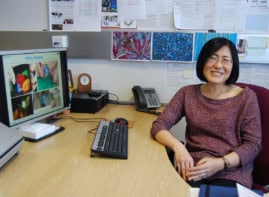Physicists are a step closer to creating the first semiconductor laser made from silicon - a device that could revolutionize optoelectronics - by coaxing significant light emission from silicon nanocrystals. Scientists have long known that silicon is reluctant to emit light. But recent advances in nanotechnology have shown that the optical characteristics of the material depend on the exact shape and dimensions of the silicon particles. Now Lorenzo Pavesi of the University of Trento in Italy and colleagues at Trento and Cantania have used silicon nanocrystals to build a device that could lead to a revolution in communications technology (L Pavesi et al 2000 Nature 408 440).
The internal energy levels of bulk silicon – in particular its ‘indirect bandgap’ – makes it emit light very inefficiently. Existing lasers are therefore based on ‘direct’ bandgap materials like gallium arsenide, which readily emit light. But these materials are expensive and difficult to integrate into the silicon chips used throughout the electronics industry.
Pavesi and co-workers sandwiched silicon nanocrystals between layers of oxidized silicon and excited the structure with green laser light. The device then emitted a much more intense beam of red light – representing a degree of amplification similar to lasers based on direct bandgap materials. Pavesi’s team believes that the interface between the silicon nanocrystals and the oxidized silicon is responsible for the success of its device. The electronic interactions that take place at the boundary appear to create many light-emitting states.
But the light is incoherent – that is, the photons are out of phase – and coherent light is a prerequisite for laser emission. A commercially viable silicon laser would also need to be electrically stimulated – rather than by another laser – for easy inclusion in microcircuits. Future investigations will focus on different configurations and topologies of silicon nanostructures in an attempt to find even more efficient light-emitting mechanisms.


